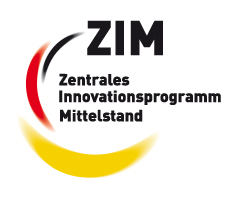


Silicon-based sensors have significantly lower quantum efficiency in the deep UV range. Our UV conversion coating absorbs UV photons and emits visible light (fluorescent down-conversion with Stokes shift), which the sensor registers much more efficiently. The result: a significantly increased useful signal in the UV range.
Our UV conversion coating method was developed by us as part of publicly funded research projects and is carried out entirely in-house. We use it to coat a wide range of CCD/CMOS sensors—line scan and area, front and back illuminated—either directly on the sensor (after removing the cover glass) or on the optical windows.

Short-wave radiation—especially deep blue light and UV—is often absorbed in the uppermost structures of front-illuminated CCD/CMOS sensors and therefore contributes little to the output signal. Effective sensitivity decreases significantly as wavelength decreases.
There are two established ways to make sensors usable for UV radiation. First, backside-illuminated (BSI) sensors: Here, the silicon is thinned down to the epitaxial layer and illuminated from the rear. This technology delivers the best results and the highest resolution, but is cost-intensive.
Secondly, UV-to-VIS conversion layers: The sensor is coated with a thin, fluorescent layer that absorbs UV photons and emits them as visible light (down conversion). Since silicon efficiently detects visible light, this significantly increases UV detectivity. Nearly every incident UV photon can be converted into a visible photon; however, due to the statistically isotropic emission direction, typically only about half of these photons reach the active area of the sensor.
The conversion layer consists of a thin film of 1-naphthalene carboxaldehyde, 2-hydroxy-, [(2-hydroxy-1-naphthalenyl)methylene]hydrazone (9CI), deposited by physical vapor deposition (PVD). The material exhibits a very high quantum yield (nearly 100 %) for excitation wavelengths below 450 nm down to 100 nm. Above 480 nm, the layer has high transmission, which means that the sensor response remains very good in the visible and near-infrared range. As is usual with crystalline coatings, the modulation transfer function (MTF) is slightly reduced at very high spatial frequencies.
Note: The actual gain depends heavily on wavelength, sensor design (front/back illumination, pixel size, microlenses), and layer parameters. We recommend a brief preliminary evaluation.
The usable excitation range of the conversion layer is typically between 150 nm and 450 nm. The emission ranges from 500 nm to 650 nm with a maximum at approximately 530 nm; the fluorescence decay time is a few nanoseconds, and measurable phosphorescence is not significant. In practical applications, the effective quantum efficiency in the specified excitation band typically corresponds to approximately 40 % of the quantum efficiency at 530 nm of the original, uncoated device (e. g., sensor).
The layer thickness is usually around 1 µm; other values are available on request. Very high spatial frequencies result in a reduction in the modulation transfer function (MTF): at 250 line pairs/mm, the MTF is typically reduced by around 50 %. The aging behavior is essentially determined by four parameters: wavelength and intensity of illumination, temperature, and atmosphere. Targeted pre-aging can reduce the temperature-sensitive portion of aging; corresponding processes are available on request.
In sensors with microlenses, the amount of fluorescent light detected is reduced because the directional sensitivity of the imaging system is highly dependent on the angle of incidence. However, the emission from the conversion layer is largely isotropic; therefore, a significant proportion of the photons arrive outside the preferred acceptance cone of the microlenses.
In practice, the typical effective quantum efficiency in the usable excitation range is between approximately 15 % and 40 % of the quantum efficiency at 530 nm of the original, uncoated device. The exact value depends in particular on the geometry of the microlenses (e. g., aperture, fill factor, pitch) and the layer thickness of the conversion. For systems with high efficiency requirements, we recommend an application-specific preliminary evaluation (e. g., with reference samples).
The development of the coating and the technology for applying it to image sensors was funded by the Central Innovation Program for SMEs (ZIM). As part of another BMBF project, a separate line scan camera family was also developed, which, among other things, uses the coated sensors. The main area of application for these systems is currently spectroscopy.

| Type | Manufacturer | Pixel Number | Pixel Size [µm²] |
Data Rate [fps or Pixel Frequenzy] |
|---|---|---|---|---|
| ICX098BL-UV | Sony | 659 x 494 | 5,6 x 5,6 | 60 fps |
| ICX414AL-UV | Sony | 692 x 504 | 9,9 x 9,9 | 60 fps |
| ICX424AL-UV | Sony | 692 x 504 | 7,4 x 7,4 | 60 fps |
| ILX554B-UV | Sony | 2048 | 14,0 x 56,0 | 2 MHz |
| TCD1205DG-UV | Toshiba | 2048 | 14,0 x 200,0 | 2 MHz |
| TCD1304DG-UV | Toshiba | 3648 | 8,0 x 200,0 | 1 MHz |
You can find more detailed information on this topic in our PDF document UV Coating of Image Sensors.
Here you can easily ask a question or inquiry about our products:
Last update: 2025-10-11
